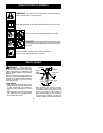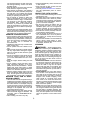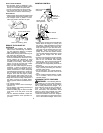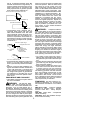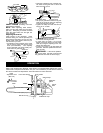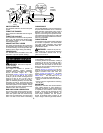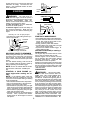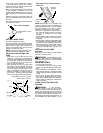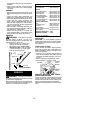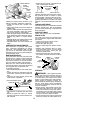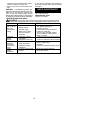
11
Look for dec ay and rot. If the trunk isrotted,
it can snap and fall toward the operator.
Check for broken or dead branches which
can fall on you while cutting.
Make sure there is enough room for the tree
to fall. Maintain a distance of
2-1/2
tree
lengths from the nearest person or other ob-
jects. Engine noise can drown out awarning
call.
Remove dirt, stones, loose bark, nails, sta-
ples, and wire fromthe tree wherecuts areto
be m ade.
Plan a clear retreat path to the rear anddiag-
onal to the line of fall.
Direction of Fall
45
_
Plan a clear retreat path
FELLING LARGE TREES
(6 inches in diameter or larger)
The notch method i s used to fell large trees.
Anotch iscut o nthe side ofthe treein thede-
sired direction of fall. After a felling cut is
made on the opposite side o f tree, the tree
will tend to fall into the notch.
NOTE:
If the tree has large buttress roots,
remove them before making the notch.
NOTCH CUT AND FELLING THE
TREE
S
Make notch cut by cutting the top of the
notch first. Cut through
1/3
of the diameter
ofthe tree. Nextcomplete the notch bycut-
ting the bottom of the notch. See illustra-
tion. Once the notch is cut remove the
notch of wood f rom the tree.
S
After removing the cutout of wood, make
the felling cut on the opposite side of the
notch. This is done by making a cut about
two inches higher than the center of the
notch. This will leave enough uncut wood
between the felling cut and the notch to
form a hinge. This hinge will help prevent
the tree from falling inthe wrong direction.
Notch
First cut
Second cut
Final (felling) cut here. 2 inches
above center of notch.
Hinge
Opening
of felling
cut
Closing of
notch
Hinge holds tree on stump and helps
control fall
NOTE:
Before felling cut is complete, use
wedges to open the cut when necessary to
control thedirection of fall. To avoidkickback
and chain damage, use wood or plastic
wedges, but never steel or iron wedges.
S
Be alert to signs that the tree is ready to
fall: cracking sounds, widening of the fell-
ing cut, or movement in the upper
branches.
S
As tree starts to fall, stop saw, put it down,
and get away quickly on your planned re-
treat path.
S
Be extremely cautious with partially fallen
trees that may bepoorly supported. When
a tree doesn’t fall completely, set the saw
aside and pull down the tree with a cable
winch, block and tackle, or tractor. Do not
cut down a partially fallen tree with your
saw.
CUTTING A FALLEN TREE
(BUCKING)
Bucking is the term used for cutting a fallen
tree to the desired log size.
WARNING:
Donot stand on the log
being cut. Any portion can roll causing loss
of footing and control. Do not s tand downhill
of the log being cut.
IMPORTANT POINTS
S
Cut only one log a t a time.
S
Cut shattered wood very carefully; sharp
pieces ofwoodcould beflung toward oper-
ator.
S
Use a sawhorse to cut small logs. Never
allow another person to hold the log while
cutting and never hold the logwith your leg
or foot.
S
Do not cut in a n area where logs, limbs,
and roots are tangled such as in a blown
down area. Drag the logs into a clear area
before cutting by pulling out exposed and
cleared logs first.
TYPES OF CUTTING USED FOR
BUCKING
WARNING:
If saw becomes
pinched or hung in a log, don’t try t o force it
out. You canlosecontrol ofthe sawresulting
in injury and/or damage to the saw. Stop the
saw, drive awedge ofplastic orwood into the
cut until the saw canbe removed easily. Re-
start thesawandcarefully reenter thecut. To
avoid kickback and chain damage, do not



